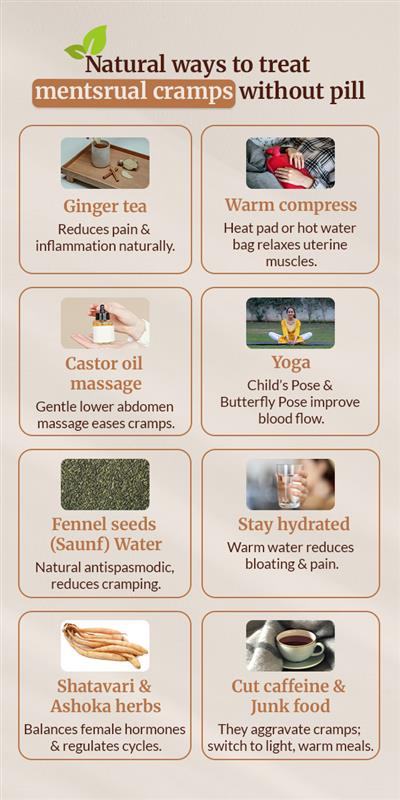For many women, menstrual cramps are a recurring and unwelcome visitor each month. The discomfort, pain, and fatigue can disrupt daily life. While over-the-counter painkillers are a common solution, many women are turning to natural, holistic methods to manage their symptoms.
Ayurveda, the ancient Indian system of medicine, offers a time-tested perspective on menstrual cramps. It views them as a result of an aggravated Vata dosha, specifically the downward-moving energy known as Apana Vayu, which is responsible for the menstrual flow. When this energy is imbalanced, it can lead to pain, anxiety, and bloating.
By balancing the Vata dosha and supporting the body’s natural rhythms, you can find relief. Here are several effective, natural ways to manage menstrual cramps without relying on pills.
1. Warming Spices
Certain household spices are packed with natural anti-inflammatory and antispasmodic properties that can ease muscle cramps.
- Fenugreek Seeds: Rich in compounds that mimic estrogen, fenugreek can help regulate hormonal fluctuations that contribute to pain.
- Carom Seeds (Ajwain): These seeds contain thymol, a powerful compound that helps relax muscles and ease digestive discomfort often associated with periods.
- Cumin Seeds: Known for their anti-inflammatory effects, cumin can help soothe a tense and sore abdomen.
To use them, simply add these spices to your meals or soak them in a glass of water overnight and drink the water in the morning.
2. Yoga and Exercise
Ayurveda and modern science agree that light, mindful movement can be highly effective. The key is to choose gentle exercises that improve blood circulation and release natural pain-relieving chemicals called endorphins.
- Child’s Pose (Balasana): This pose gently stretches the lower back and pelvis, relieving tension and pressure.
- Cobra Pose (Bhujangasana): This pose helps stimulate the abdominal and reproductive organs, improving circulation and reducing cramps.
- Bridge Pose (Setu Bandha Sarvangasana): This pose opens up the pelvic area and promotes blood flow, which can provide significant relief.
3. Ayurvedic Herbs
Ayurveda has long used specific herbs to support women’s health.
- Shatavari: Known as the “female-friendly herb,” Shatavari is a powerful adaptogen that helps the body cope with stress and hormonal shifts. Its anti-inflammatory properties can also help reduce the pain and discomfort of cramps. You can take it as a powder mixed with warm milk or water, or in tablet form.
- Ginger: Beyond its use in tea, ginger is a potent anti-inflammatory that contains gingerol, which helps reduce pain similar to some over-the-counter medications.
- Fennel: This herb acts as a muscle relaxant and can help reduce the severity of uterine contractions.
4. Warm Beverages
Drinking warm liquids is a key Ayurvedic principle for calming Vata. Herbal teas can provide both warmth and therapeutic benefits.
- Ginger Tea: A classic for a reason, ginger tea can reduce inflammation and soothe the stomach.
- Chamomile Tea: This is a natural muscle relaxant that can help calm both your mind and your muscles.
- Fennel Tea: Gentle and effective, fennel tea can ease bloating and reduce spasms.
5. Warm Oil Massage and Heat Therapy
Massaging the lower abdomen can help relax sore muscles and improve circulation. Gently but firmly massage the area using a warm oil like sesame oil, which has natural warming and anti-inflammatory properties. For added relief, you can apply a hot water bottle or a heating pad to your lower abdomen. The warmth helps to soothe muscle tension and reduce pain.
Menstrual cramps don’t have to be a monthly ordeal. By adopting an Ayurvedic approach, you can go beyond simply managing the pain and address the root cause—an imbalance of Vata. By making simple, consistent changes to your diet, lifestyle, and self-care routine, you can find lasting relief and bring a sense of balance back to your body.













